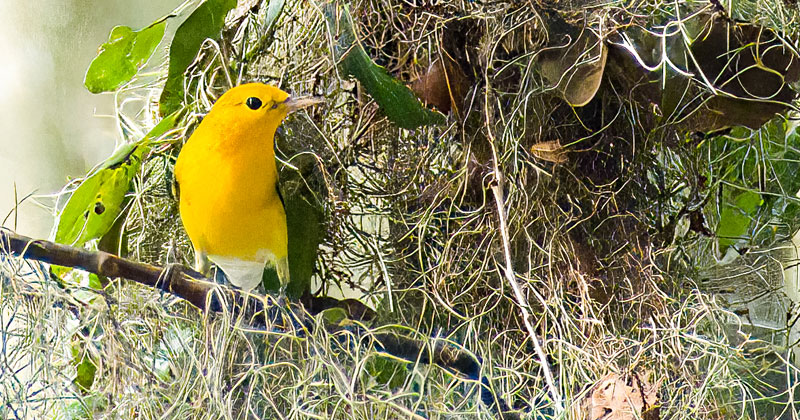Prothonotary Warbler Elegance

by Juanita Baker, Ph.D.
Such elegance, this male Prothonotary Warbler (Protonotaria citrea)! Brilliant yellow head with black eye and long bill, its smooth gorgeous feathers contrast with the curling, twisting Spanish Moss that this warbler uses for nest building. This is the only eastern wood-warbler that nests in tree cavities (often Downy Woodpecker’s excavations), cypress knees, or stumps [the reason why cypress mulch must be prohibited to retain their habitats]. The male gathers moss and places it in several different cavities to attract a mate! The moss helps stabilize the nest temperature and humidity. His mate chooses the best nesting location and completes its construction! The male stands guard to protect the nestlings and even accompanies her to “safeguard” her coming to and from their nest.
This migratory wood warbler is usually found in low-lying edges of forests near running water or wetlands—but not in the center of the forests. Of all warblers, they are one of the earliest to migrate north by early March from wintering grounds in South America in northern parts of Ecuador, Colombia, Venezuela, and central America to Cuba and the Dry Tortugas. Flying at night, they land on the Gulf Coast, and in two days, rapidly restore their fat reserves, gaining 5% of their body weight each day. Once in south Florida they head to lowland habitats in northern counties where this photo was taken. They search for flowing water like rivers and lakes, seasonally flooded wetlands and even backyard ponds and swimming pools, where in low foliage or mangroves, they forage amongst leaves, twigs, and bark on branches. Insects and their larvae are their primary food source, along with wood lice, snails, and slugs.
Other individuals migrate further north in a wide swath from Texas to the East Coast, north to New Jersey across southern Michigan and Minnesota. After nesting, feeding, and rearing young to independence within a month, half the parents have a second brood before returning south in August. This male’s bill is not all black as in breeding and nest building but has a brown upper and pale pink lower bill, indicating that it is no longer breeding but ready to return south for the winter as one of the earliest migrants. Their immature young follow when they have built fat reserves for the long migration. It is astounding that the young’s navigation system is programmed into their brains to find their way south thousands of miles on their own without parental guidance!
Birding trains us to notice beauty that most people miss. Photography allows us to share it as well… —Brent Henderson

